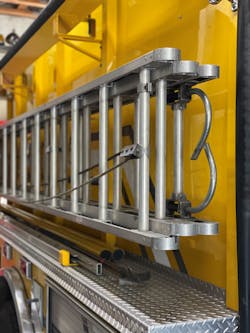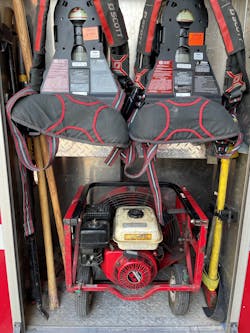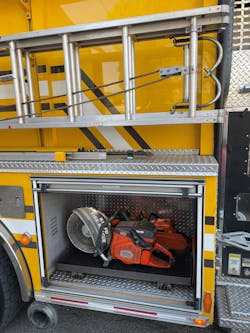“Chief 101 to Engine 103. On arrival your assignment is search on the A side second division.”
A thought quickly comes to Engine 103: “Wait a second. I’m a responding engine company in a rural community. This is truck company work. We are only a responding engine company.”
The truth of the matter is that the rural fire environment is no different than that of its suburban and urban counterparts. Traditional truck company functions of forcible entry, ventilation, and search and rescue must be performed on the fireground. The difference lies in the fact that most rural fire departments are set up primarily for fire attack and water supply. Nevertheless, rural firefighters must be able to accomplish the traditional role of the truck company from an engine apparatus.
Even so, the priority of hose placement and appliances for water supply and fire attack tend to take precedence in both the design of an apparatus and the training of members. However, this must not hinder the engine apparatus’ ability to conduct rural truck company operations, accomplished at the department level by setting up the engine for such operations and training firefighters to accomplish the tasks.
Search and Rescue
According to the NFPA’s 2017 study of rural fires, the rate of civilian fire deaths per one million people in communities of fewer than 2,500 is 20.9 compared with the national average of 10.9. The first priority on the rural fireground should be the rescue of any possible victims, and rural departments must have a plan for this on arrival. That means that firefighters must be prepared for the assignment of search, and, at a minimum, they must have the ability to equip themselves with a thermal imager and a set of irons.
Firefighters must be able to conduct a quick primary search. The fundamental search methods that are taught in Basic Firefighter schools—oriented search and VEIS (vent enter isolate search)—are great to build off of.VEIS often brings uneasiness among rural incident commanders because of firefighters operating in the fire environment without the protection of a handline. Although firefighters do lose the ability to extinguish fire that might be encountered, what they gain is mobility and speed during the search.
VEIS is a tactic that’s best utilized for known victim locations for quick access and removal of the victim. Quick access is gained by having a direct point A-to-point B route to the victim without having to enter the structure from a main entry point. The basic engine company has all of the equipment that’s needed (ladders and forcible entry tools) to perform this tactic. What’s good to note is that this skill can be performed on both the ground floor and the upper levels of a structure. The focus is quick removal of a fire victim.
Laddering the building
A task that’s associated with traditional truck company operations is laddering the building. This can be done either to gain access to a window or to a roof. The difference in performing laddering operations from an aerial apparatus and an engine is the number of portable ladders that are available and their accessibility for ladder deployment.
Aerial apparatus typically have numerous ladders to select. Most ladder apparatus have at least six portable ladders in various lengths and configurations. In contrast, a typical engine apparatus only has three main ladders. These usually are a 24-foot extension ladder, a 14-foot roof ladder and a 12-foot attic ladder. This means that the rural engine must prioritize ladder placement.
Ladder accessibility on the apparatus often presents a challenge. Most ladders on ladder apparatus are stored in a rear-mount compartment. This allows firefighters to choose which ladder they need to utilize independent of the other ladders. The typical rural engine finds ladders stored on the side of the apparatus, and most departments I have seen them store their ladders with the 24-foot extension bedded first and the 14-foot roof ladder stored on the outside. This approach increases the time that it takes to access the extension ladder. Departments that store the two ladders this way might want to change the setup.Forcible entry
Every rural firefighter must have the ability to gain entry into a building. This can be performed with minimal tools and, ideally, by two people, but the truth of the rural environment is that this skill most likely will be performed by one firefighter.
The availability of forcible entry tools is a must on the rural apparatus. The forcible entry tools of choice are a traditional set of irons. The set of irons traditionally comprises a flathead axe and a Halligan bar. A six-foot New York roof hook increases the abilities of the firefighter to perform forcible entry.
Ventilation
Performing ventilation can be a challenge in the rural arena. Often, departments are restricted to a limited amount of staffing on scene. So, they must perform a ventilation tactic that allows for the greatest utilization of resources. On most residential fires, horizontal ventilation coupled with positive pressure ventilation (PPV) allow for the fastest method of smoke and heat removal of a building while not being a drain on the precious pool of firefighters.
A caution on PPV: Close coordination should be utilized. Improper ventilation via PPV can cause rapid fire spread or a flashover. This could result in unnecessary property damage or the injury/death of fellow firefighters.
For the rural fire department to be capable of performing ventilation, the engine must have some form of ventilation fan on the apparatus. Departments have multiple options. These include battery- or gasoline-powered PPV fans and electric box-style fans, such as smoke ejectors. Weight must be considered because of the limited staffing of the rural agency and the need for a single firefighter to place the equipment into service.
Hooks and saws—as well as the aforementioned ladders and forcible entry tools—are needed, too. To make these items most accessible, the department must dedicate a single compartment to all of the tools. This allows a firefighter to retrieve them without having to open multiple compartments.
Training needs
The training of rural firefighters to perform traditional truck company functions must be a priority.
Often during training, firefighters perform skills with the ideal number of firefighters to perform a task. This is unrealistic for rural department members. The focus must be on how to perform the tasks with less staffing, with the goal still being to build confidence and proficiency.
Search and rescue skills should be practiced without the protection of a hoseline. This assists in developing better search techniques and confidence in orientation without a search aid. In addition, incorporate the use of VEIS to gain quick access to victims, and practice removal by a single firefighter to a window.
Ladder practice should be completed by a single firefighter with the ladders that are in the mounted position on the apparatus. Have individual firefighters practice throwing ladders to different heights.
Change of mindset
Rural agencies shouldn’t believe that traditional truck company tactics only can be performed from a ladder apparatus. The tactics can be performed from an existing engine apparatus if simple changes in equipment setups and equipment availability are made and with training of firefighters that accounts for minimal staffing.
About the Author

Justin Bailey
Justin Bailey is the fire chief of the Oliver Springs, TN, Fire Department and a 20-year student of the fire service. He also holds the rank of master firefighter with the Knoxville, TN, Fire Department, where he has served since 2007. Bailey has an associate degree in allied health science from Roane State Community College and a bachelor's degree in fire administration from Columbia Southern University. He speaks regionally and nationally on the topics of volunteer training program development, professional development and rural fireground management.


